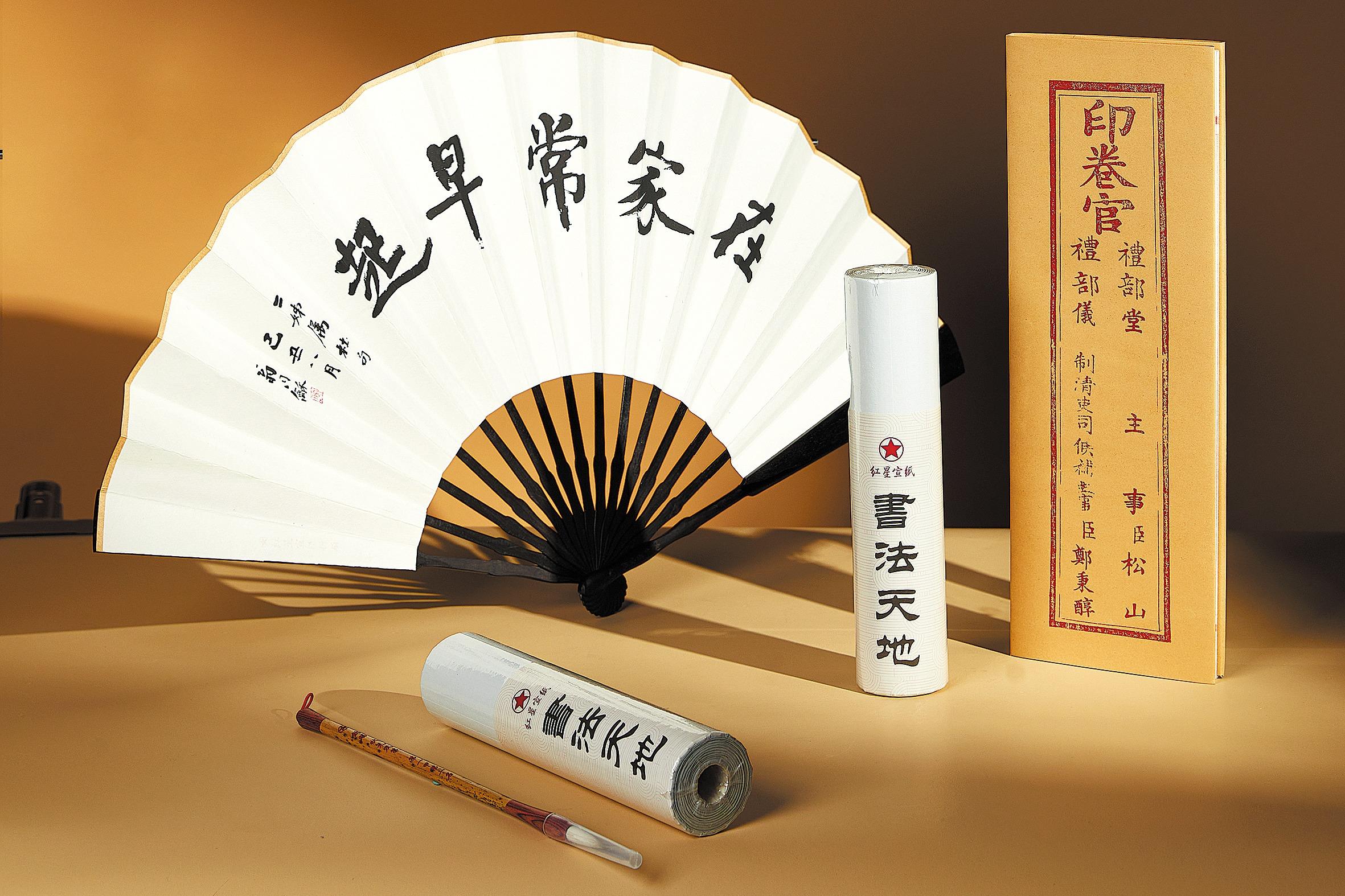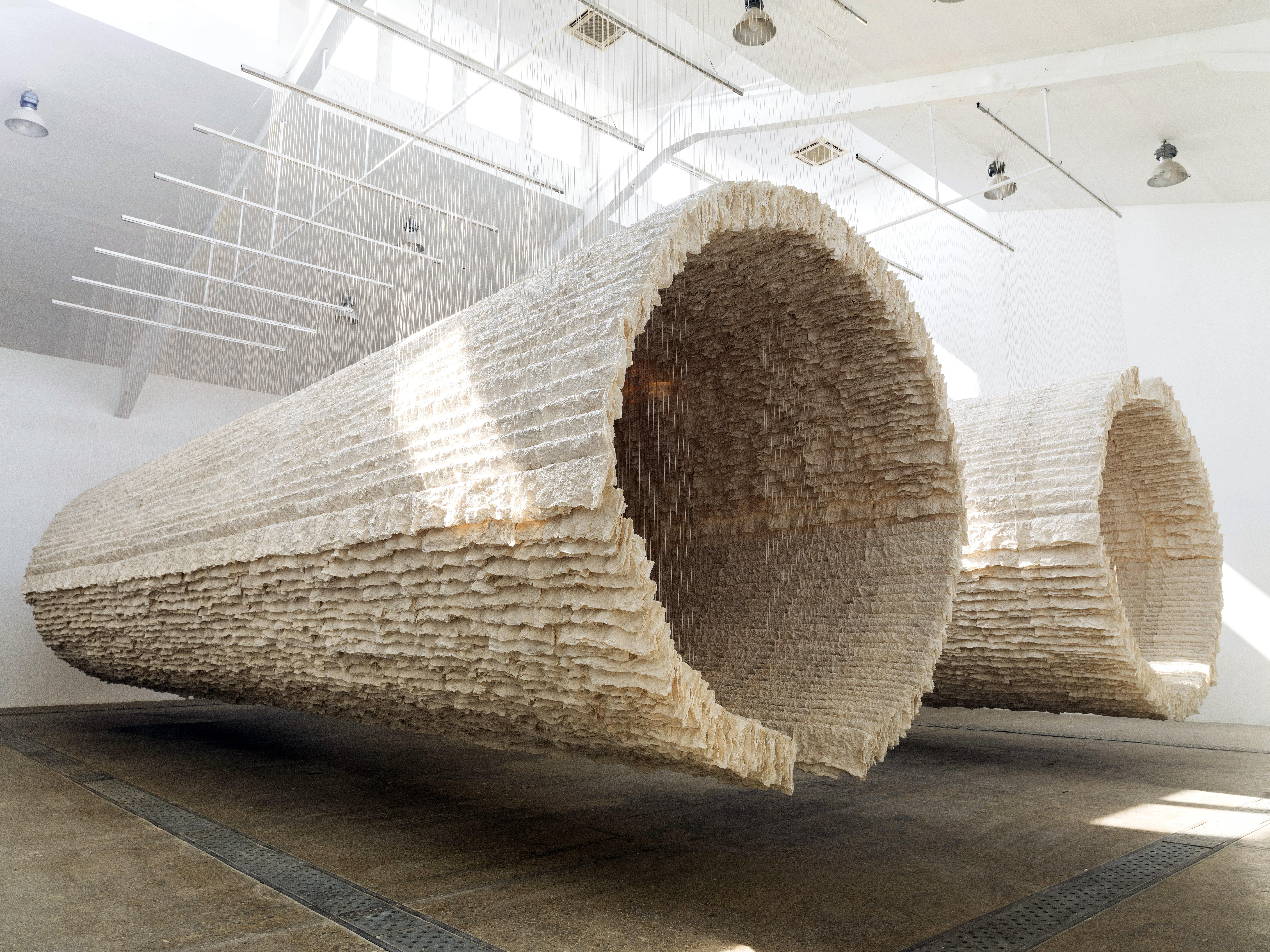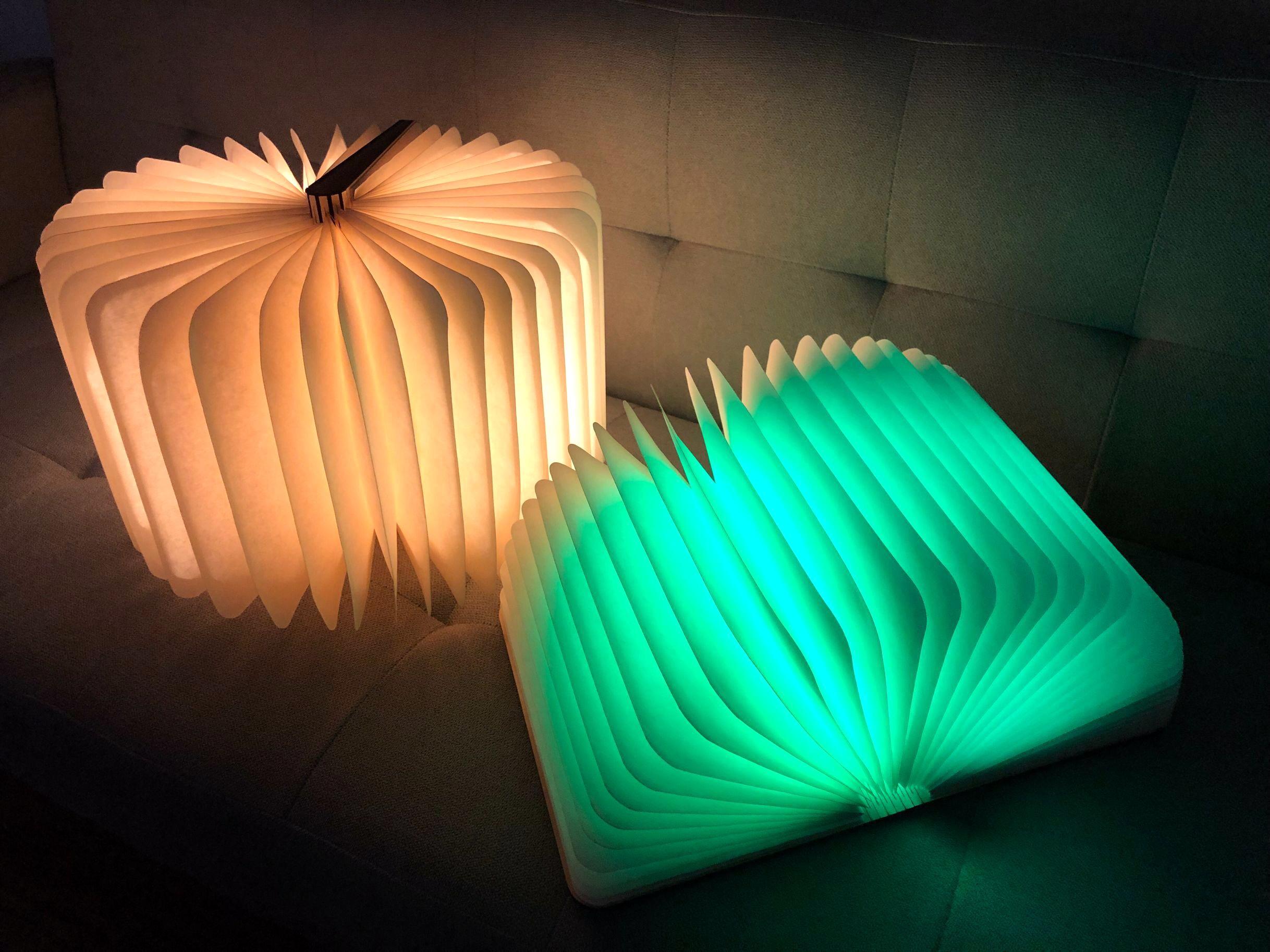 Foldable fans and lanterns are popular products made by the China Xuan Paper Group. (PHOTO PROVIDED TO CHINA DAILY)
Foldable fans and lanterns are popular products made by the China Xuan Paper Group. (PHOTO PROVIDED TO CHINA DAILY)
Amid the spectacle of the 2008 Beijing Olympics opening ceremony, the colossal screen in the Bird's Nest stadium displayed the process of creating a traditional Chinese painting — from the making of Xuan paper and the delicate brushwork applied to its surface, to the art of mounting the finished masterpiece on a scroll.
The short film not only showcased the allure of China's "four treasures of the study" — namely Xuan paper, brushes, ink and ink slabs — but also conveyed the serenity of classical Chinese art.
Xuan paper installations can transform people’s perception of time. When you find yourself inside them, it feels as if you have transcended to another realm.
Zhu Jinshi, artist
Clad in pristine white robes, craftspeople skillfully executed the steps involved in making Xuan paper, an exquisite and enduring material closely associated with Chinese calligraphy and paintings.
The age-old craft continues to be faithfully practiced by a dedicated group of craftspeople in Jingxian county, Xuancheng, Anhui province. The enduring tradition has not only made the county one of the country's leading hubs for handmade paper, it has also breathed new life into its culture and tourism sectors.
Nestled at the base of emerald hills in Jingxian is a striking white structure, its main body built from steel to resemble a stack of gracefully arranged paper.
This is the Xuan Paper Museum. It is dedicated to the history and craft of Xuan paper production and also hosts exhibitions of masterpieces of traditional calligraphy and painting.
 A paper installation created by Zhu Jinshi. (PHOTO PROVIDED TO CHINA DAILY)
A paper installation created by Zhu Jinshi. (PHOTO PROVIDED TO CHINA DAILY)
The museum, which opened to the public in 2016, is part of the Xuan Paper Cultural Park, where people can visit workshops to experience the traditional way Xuan paper is made. During the recent summer vacation, many primary and middle school students went to visit.
One of them was Hu Yuguo, a primary school pupil from Ma'anshan, Anhui province, who followed the papermaking masters as they dipped a bamboo screen in a pool of pulp, and then got hands-on experience by lifting a sheet of paper from the pool.
The sheet was then sent to be sun-dried and cut before being packed in an elegant box, which Hu took home as a memento. "It's truly magical to watch the tough bark of the sandalwood tree and rice straw undergo various processes to ultimately become Xuan paper. I'm going to keep the paper I made safely," says Hu.
Yao Yunkui works in one of the workshops, where he plays a crucial role in the process of drying.
The 32-year-old takes the wet paper sheets, which are lifted from the pulp pool, and carefully places them on a drying wall — a vital heating apparatus used during the sunning phase of production.
He then uses a brush to smooth out the paper's surface. During this process, the paper sheets adhere to the wall and dry gradually to become finished Xuan paper.
 Foldable fans and lanterns are popular products made by the China Xuan Paper Group. (PHOTO PROVIDED TO CHINA DAILY)
Foldable fans and lanterns are popular products made by the China Xuan Paper Group. (PHOTO PROVIDED TO CHINA DAILY)
Yao is the youngest member of the team, and he has the demanding task of drying 500 sheets of paper every day. Once he meets his daily workload, he dedicates time to filming short videos demonstrating the papermaking process in the various workshops, which he shares online. To his surprise, many have garnered millions of views and as a result, Yao has amassed over 120,000 followers on the short-video platform Douyin, and 25,000 on Xiaohongshu.
"I started creating these clips back in 2017 and shared them online for fun," he explains. "Surprisingly, many of the videos became popular. Viewers would ask me how to buy proper Xuan paper for a range of uses. That has motivated me to keep producing the videos."
Last year, Yao, who is also an employee of the China Xuan Paper Group, began endorsing Xuan paper and products through livestreaming.
Apart from producing paper in a variety of sizes, the corporation also manufactures a wide array of cultural and creative products made from the paper, such as foldable lanterns shaped like books and small paper umbrellas.
According to Huang Yingfu, deputy chief manager of China Xuan Paper Group, the corporation is also actively expanding the use of Xuan paper in areas such as stamp production, book printing, and as paper used for the restoration of cultural artifacts.
Xuan paper is known for its strength and smoothness, its capacity to absorb water and ink, and ability to be folded repeatedly without tearing and remain durable over time.
 A demonstration center displays traditional handicrafts of making Xuan paper in Jingxian county, Anhui province, as part of local government's efforts to develop cultural tourism. (WANG DACHOU / FOR CHINA DAILY)
A demonstration center displays traditional handicrafts of making Xuan paper in Jingxian county, Anhui province, as part of local government's efforts to develop cultural tourism. (WANG DACHOU / FOR CHINA DAILY)
This enduring quality prompted the cultural company Sanxitang to set up a branch in Jingxian dedicated to using Xuan paper to reproduce printed treasures like Siku Quanshu, an encyclopedia compiled under the edict of Emperor Qianlong during the Qing Dynasty (1644-1911).
Chen Guanglan, manager of Sanxitang's Jingxian branch, firmly advocates for the trustworthiness of Xuan paper over digital methods when it comes to preserving ancient texts.
"I believe that digitalization is merely of temporary use, incapable of serving as a lasting tool for the development and perpetuation of traditional cultural heritage. We place greater trust in preserving our cultural legacy through traditional means," she says.
Sanxitang reproduces copies of these ancient classics in the traditional Chinese thread-bound book format and displays them in the company's exhibition hall.
In the contemporary art world, the ageold, humble material also remains a source of vitality and inspiration, inspiring artists to create unconventional installations.
For instance, among the exhibits of the ongoing Chengdu Biennale 2023, Zhu Jinshi's pillar-like installation, which stands 12 meters tall and has a diameter of 3.5 meters, is made using an internal steel frame covered with Xuan paper.
He has named the piece Du Fu Tower, in tribute to the famous Tang Dynasty (618-907) poet Du Fu.
Zhu's exploration of the use of Xuan paper in art installations dates back to 1988. Living in Berlin at the time, he created an installation using a cubic meter of linen fabric.
 A demonstration center displays traditional handicrafts of making Xuan paper in Jingxian county, Anhui province, as part of local government's efforts to develop cultural tourism. (WANG DACHOU / FOR CHINA DAILY)
A demonstration center displays traditional handicrafts of making Xuan paper in Jingxian county, Anhui province, as part of local government's efforts to develop cultural tourism. (WANG DACHOU / FOR CHINA DAILY)
Simultaneously, he asked a friend in Beijing to make a twin piece using a cubic meter of Xuan paper. When combined, the two components created a work of art known as Fang Zhen, which embodied the notion of East-West dialogue.
Since then, Zhu has frequently made Xuan paper installations, which have been exhibited in a number of countries, including China, Germany, Japan, Canada and the Czech Republic. In order to make these installations easier to preserve, his team developed a type of Xuan paper with fire-resistant properties.
In 2018, Zhu used 14,000 sheets of Xuan paper, 1,800 fine bamboo sticks and 2,000 7-meter-long cotton threads to make a large-scale installation titled The Ship of Time.
It resembles a tunnel through which visitors can walk to see floating specks of light on the folded surface of the Xuan paper, and creates an immersive experience that resonates both with the ancient material and the theme of time.
"Xuan paper installations can transform people's perception of time," says Zhu. "When you find yourself inside them, it feels as if you have transcended to another realm. Many of my exhibitions have been extended due to the enthusiastic response of the audience for the Xuan paper pieces."
Explaining why he has been using the paper for so long, Zhu says that his installations are the product of challenging traditional forms of calligraphy and painting on Xuan paper.
Their primary purpose is to defy tradition, possibly representing a new ideology in Asian art, while still honoring the historical significance of the ancient materials used, he says.
Contact the writers at xingwen@chinadaily.com.cn


